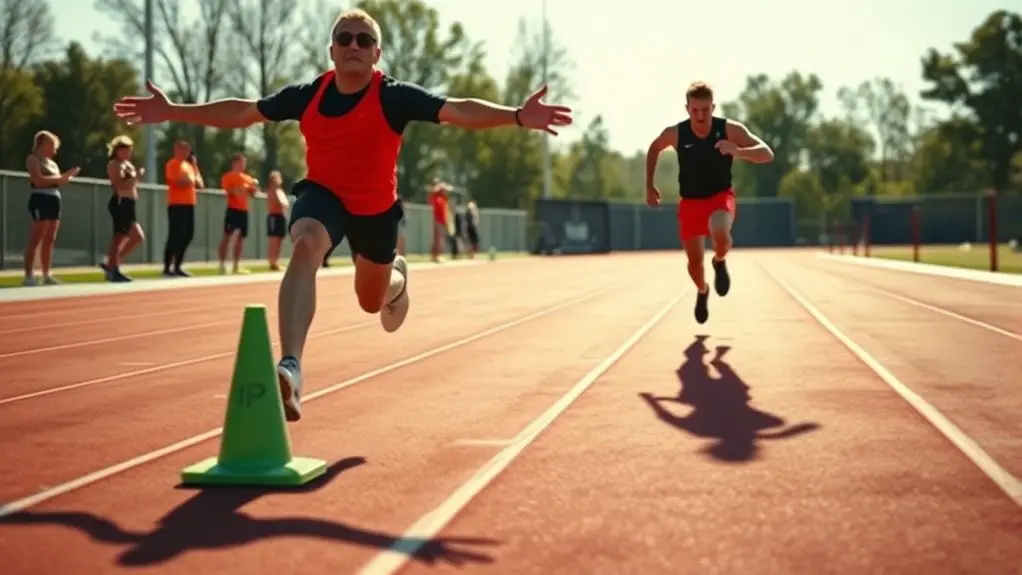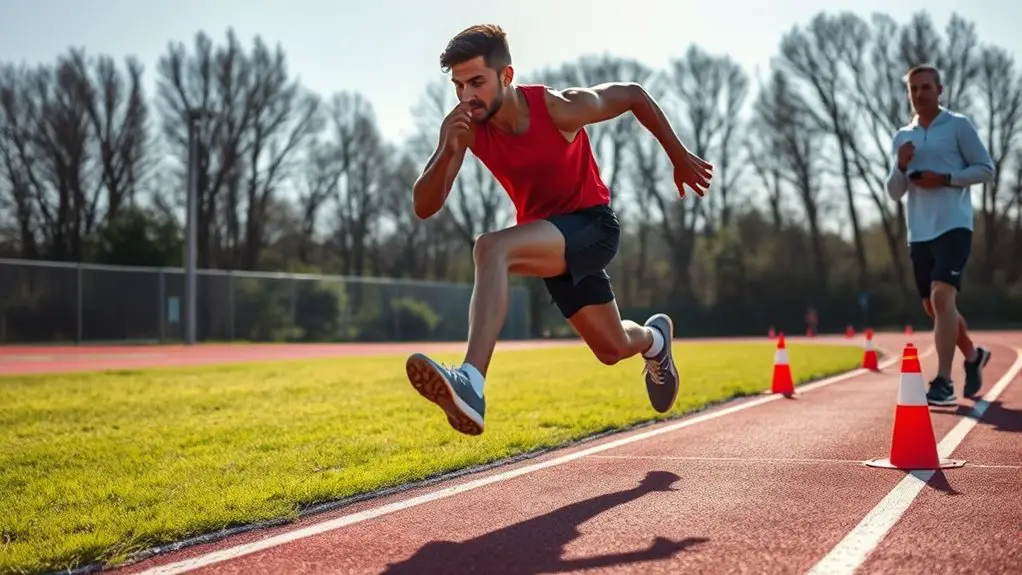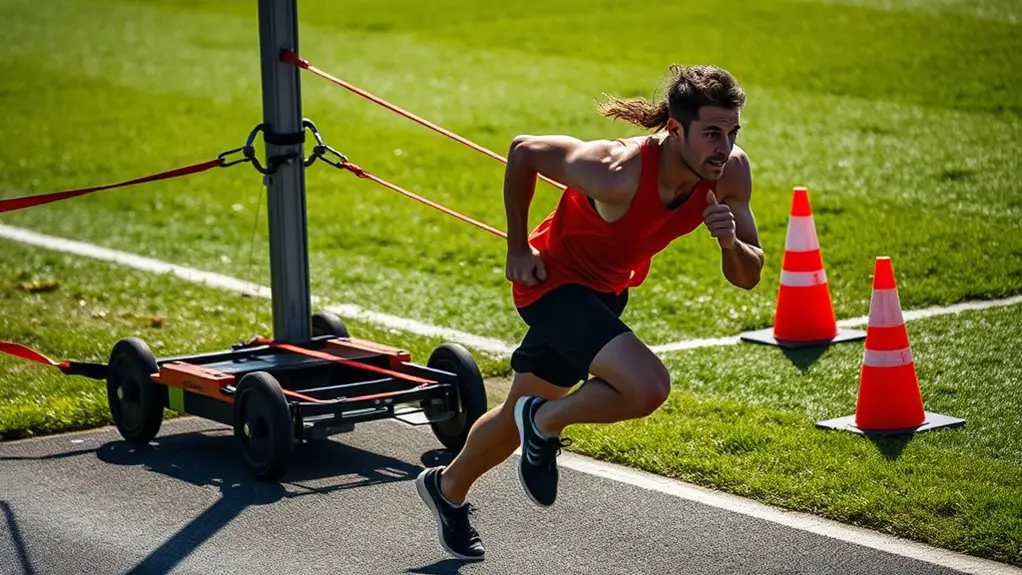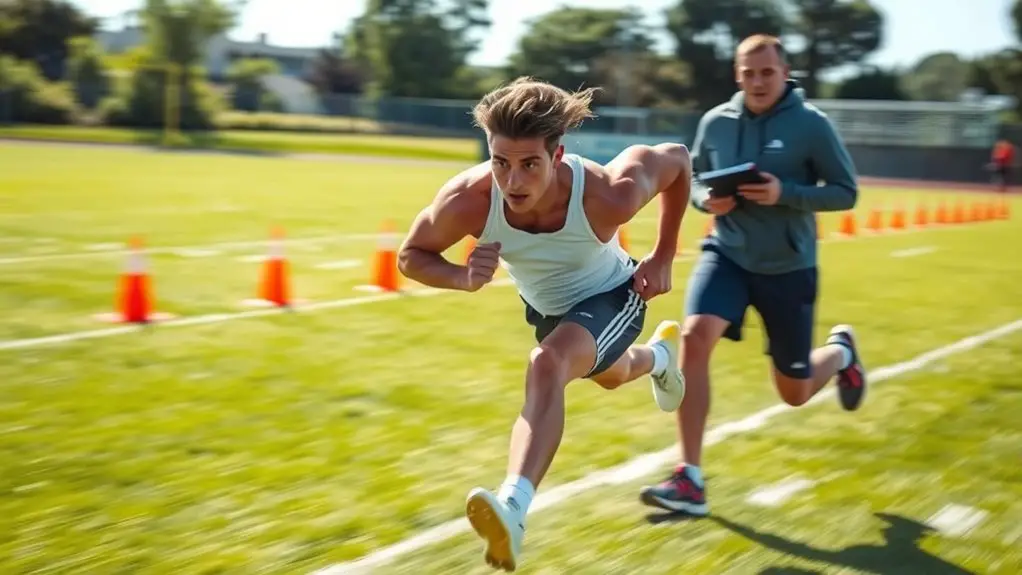The Best Drills for Acceleration in Sports

To improve your acceleration in sports, focus on incorporating a mix of plyometric drills like box jumps, sprint technique exercises such as high knees and butt kicks, resistance training with squats and lunges, and agility drills including ladder and cone exercises. Tailor these workouts specific to your sport for maximum benefit. These drills not only enhance explosive power and speed but also sharpen your overall performance. Keep exploring to discover more effective strategies for enhancing your acceleration.
Plyometric Drills for Explosive Power

Plyometric drills are fundamental for building explosive power, which is essential for improving your acceleration in sports. Incorporating exercises like box jumps and depth jumps into your training routine can considerably enhance your performance.
Box jumps involve jumping onto a sturdy platform, engaging your leg muscles and promoting fast-twitch muscle fiber development. Focus on landing softly to absorb impact, which helps prevent injury. Start with a height that challenges you but allows for proper form.
Depth jumps are another powerful plyometric exercise. By stepping off a box and immediately jumping upon landing, you train your body to react explosively. This drill increases your reactive strength, vital for accelerating quickly in any sport.
Consistency is key; aim to include these drills in your weekly regimen. By regularly practicing box jumps and depth jumps, you’ll notice improved acceleration, making you a more formidable competitor on the field or court.
Sprint Technique Exercises
While explosive power is essential, mastering sprint technique is equally important for maximizing your acceleration in sports. Focusing on your sprint form can greatly improve your stride length and overall speed. Here are four effective sprint technique exercises you should incorporate into your training routine:
- High Knees: This drill emphasizes knee lift, helping you develop a powerful sprint form that promotes better acceleration.
- Butt Kicks: Focusing on driving your heels towards your glutes enhances your leg recovery and improves stride length.
- A-Skip Drills: This exercise teaches proper leg movement and foot placement, reinforcing an efficient sprint form.
- B-Skip Drills: Building on the A-skip, this drill incorporates an extended leg forward, which helps in optimizing your stride length.
Integrating these exercises will refine your technique, leading to increased acceleration on the field or track.
Resistance Training for Acceleration

Incorporating resistance training into your regimen can greatly enhance your acceleration in sports. When you focus on strength training, you’re building the foundational power needed for explosive starts. Adding weighted sleds to your routine can further amplify your acceleration by increasing resistance, forcing your muscles to adapt and strengthen.
Here’s a quick overview of effective resistance training methods:
| Exercise | Benefits |
|---|---|
| Weighted Sled Pulls | Improves force production |
| Squats | Builds lower body strength |
| Deadlifts | Enhances overall power |
| Lunges | Increases unilateral strength |
| Plyometric Jumps | Boosts explosive power |
Incorporate these exercises into your training plan, and you’ll notice significant improvements in your speed and acceleration on the field. Remember, consistency and proper form are key to maximizing your results.
Agility Drills to Enhance Quickness
Building strength through resistance training is a solid foundation for improving your acceleration, but agility drills are equally important for enhancing your quickness on the field. These drills focus on footwork and reaction time, allowing you to respond quickly to dynamic situations during play. Here are four effective agility drills to incorporate into your training regimen:
Building strength is essential, but agility drills sharpen footwork and reaction time for peak performance on the field.
- Ladder Drills: Use an agility ladder to improve foot speed and coordination. Quick, precise foot placements enhance your overall agility.
- Cone Drills: Set up cones in a zigzag pattern. Sprint between them, focusing on sharp turns and quick changes of direction to boost your reaction time.
- T-Drill: Sprint forward, shuffle side to side, and backpedal to develop multidirectional agility.
- Box Jumps: Jump onto a sturdy box to build explosive leg strength, which contributes to faster acceleration and agility.
Incorporate these drills to elevate your athletic performance!
Sport-Specific Acceleration Workouts

To maximize your acceleration in a sport, it’s essential to tailor your workouts to the specific demands of that activity. Understanding acceleration mechanics is vital; you need to focus on the explosive movements and muscle engagement that your sport requires. For instance, sprinters should concentrate on block starts and short sprints, while soccer players might benefit from drills that enhance quick directional changes.
Incorporating sport adaptations into your training can greatly improve your performance. For basketball, practice sprinting followed by a jump shot to simulate game scenarios. Hockey players should include skating drills that emphasize quick bursts of speed.
Frequently Asked Questions
How Often Should I Incorporate Acceleration Drills Into My Training Routine?
When considering how often to incorporate acceleration drills into your training routine, aim for a frequency of 2 to 3 times a week. This allows your body adequate recovery while still improving your speed. It’s important to integrate these drills into your training schedules on days when you’re not doing heavy strength work. Always listen to your body, adjusting frequency guidelines based on your overall training load and goals.
What Is the Ideal Duration for Each Acceleration Drill?
Think of your acceleration drills as a finely tuned engine—too much time revving can lead to burnout, while too little won’t get you moving. For ideal timing, aim for each drill duration to be between 10 to 20 seconds. This allows for maximum intensity without sacrificing form. Incorporate short rest intervals between sets to maintain peak performance. Remember, quality over quantity is key to releasing your true speed potential.
Can I Perform These Drills Indoors?
Yes, you can perform these drills indoors if you have enough indoor space and the right equipment. Look for a spacious area free of obstacles, like a gym or a large room. Make certain you have access to equipment like cones or agility ladders to enhance your training. Just be mindful of the surface; a smooth floor will allow for better acceleration. With the right setup, you can effectively train indoors without any issues.
At What Age Can Athletes Start Acceleration Training?
Like a plant reaching for the sun, your journey in youth training can start early. Generally, athletes can begin acceleration training around age 8, but age considerations matter. It’s essential to focus on proper technique and body awareness first. As they grow, you can gradually introduce more specific drills. Remember, fostering a love for movement is key, so keep it fun and engaging while laying a strong foundation for their future athletic development.
What Warm-Up Exercises Are Best Before Acceleration Drills?
Before you plunge into acceleration drills, it’s essential to warm up properly. Start with dynamic stretches like leg swings and arm circles to increase blood flow and flexibility. Incorporating mobility exercises, such as hip openers and ankle rolls, can enhance your range of motion. These warm-up activities not only prepare your muscles but also help prevent injuries, ensuring you’re ready to perform at your best during your acceleration training.





